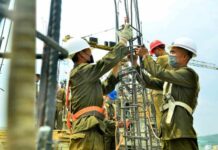North Korea has recently been making plans to revitalize its tourism industry, one of the few legal avenues for the regime to earn foreign currency. Revitalization plans include instructions to import materials needed to complete construction of the Wonsan-Kalma Coastal Tourist Zone and to draft plans for attracting foreign investment.
Speaking on condition of anonymity for security reasons, a source inside the country told Daily NK on Nov. 30 that “last week, the Workers’ Party of Korea’s economic department and the Cabinet’s foreign trade division issued joint instructions to central government trade institutions and the Ministry of External Economic Relations [MEER] to include materials for finishing construction at Wonsan-Kalma in their trade plans for next year.”
The Wonsan-Kalma Coastal Tourism Zone is one of Kim Jong Un’s pet projects, a tourism complex taking up part of Wonsan city and outfitted with hotels, recreation facilities, a water park, and airfield. This massive construction project was originally scheduled to be completed in 2019, but the project has been mired in delays after the project ran into difficulties securing funding and materials during the COVID-19 pandemic.
However, the authorities have designated materials and other items needed to finish construction of the Wonsan-Kalma complex as priority import items. State-affiliated trade enterprises were told to divvy up responsibility for importing these items and include them in their trade plans for next year.
As the threat of COVID-19 subsides in North Korea, tourism construction projects temporarily suspended during the pandemic have resumed at a hurried pace.
As part of its strategy to resolve construction budget shortfalls, MEER is working on plans to attract investment in the Kalma-Wonsan complex from individuals and organizations in China and Russia. This strategy appears to be part of a move to attract foreign capital for tourism construction projects.
However, some officials in North Korea have raised concerns about the feasibility of attracting foreign investment.
“Workers at MEER had tried to attract foreign investment prior to COVID-19 but ran into substantial difficulties. Now those officials are taking a laid-back approach to the most recent orders [to attract foreign investment],” the source explained.
“Workers at MEER have pointed out that this is a fundamentally different project from rural housing construction, where local governments used investment from donjuLiterally "masters of money," donju refers to people who hav... More to put up the frames of new buildings,” the source continued, using a term referring to North Korea’s wealthy entrepreneurial class. “MEER and state-run trade enterprises see this as a problem they can’t tackle on their own, and if the state doesn’t invest all it can [in Wonsan-Kalma] then there’s no way to carry out the project.”
In 2014, the Presidium of the People’s Assembly issued Order No. 48, which called for the official development of the “Wonsan-Mt. Kumgang International Tourist Zone.” This tourism zone would feature six major attractions: Wonsan Coastal Zone, Masikryong Ski Resort, Ullim Falls, Sokwang Temple, Thongchon, and Mt. Kumgang Resort. The Wonsan-Kalma Coastal Tourism Zone was included under plans for development of the greater Wonsan Coastal Zone as part of the tourism initiative.
Translated by Rose Adams. Edited by Robert Lauler.
Daily NK works with a network of sources who live inside North Korea, China and elsewhere. Their identities remain anonymous due to security concerns. More information about Daily NK’s reporting partner network and information gathering activities can be found on our FAQ page here.
Please direct any comments or questions about this article to dailynkenglish@uni-media.net.


















